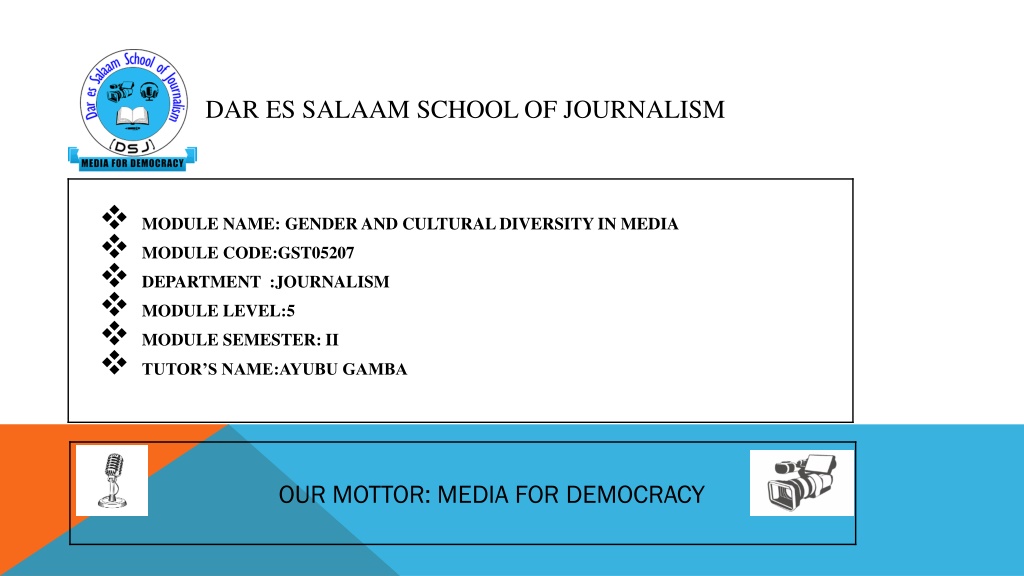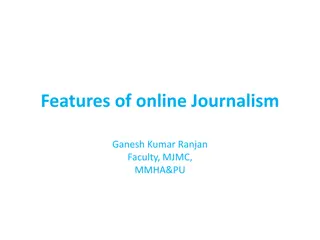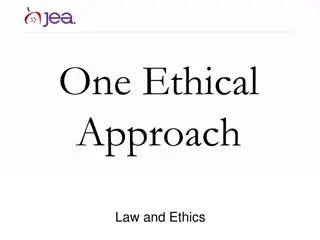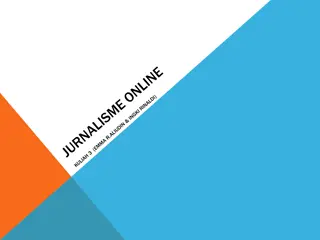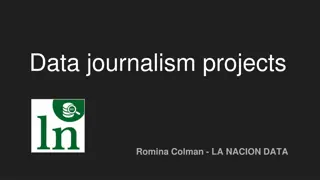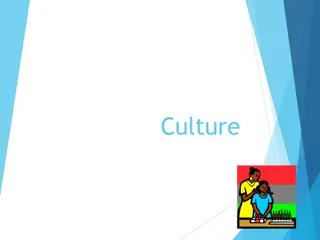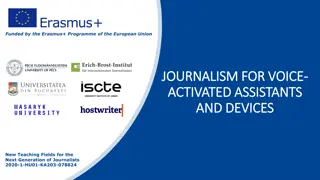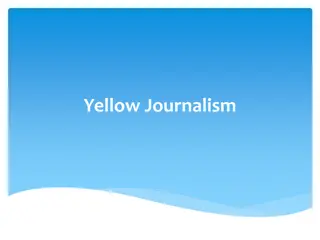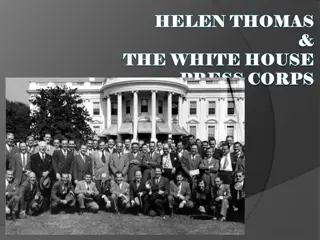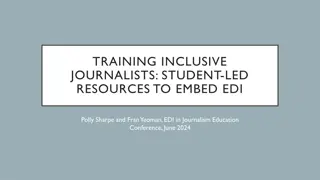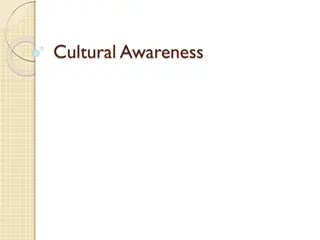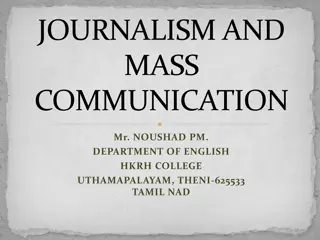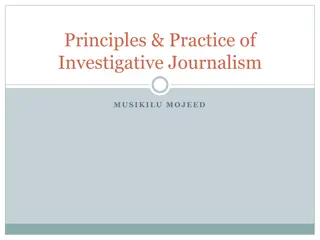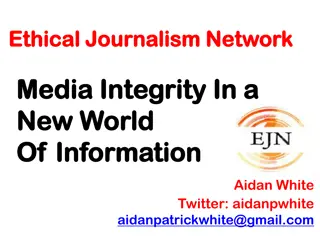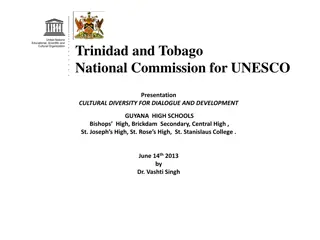Cultural Diversity and Journalism Practices
Cultural diversity in journalism is essential for recognizing, respecting, and valuing different cultural expressions. It promotes empowerment, contribution from diverse groups, and celebrates differences. The importance of cultural diversity in journalism lies in acknowledging the variety of cultures in the world, respecting differences, and empowering diverse voices. Dos and Don'ts in journalism practices highlight the significance of research, preparation, asking the right questions, and establishing rapport with news sources.
Download Presentation

Please find below an Image/Link to download the presentation.
The content on the website is provided AS IS for your information and personal use only. It may not be sold, licensed, or shared on other websites without obtaining consent from the author.If you encounter any issues during the download, it is possible that the publisher has removed the file from their server.
You are allowed to download the files provided on this website for personal or commercial use, subject to the condition that they are used lawfully. All files are the property of their respective owners.
The content on the website is provided AS IS for your information and personal use only. It may not be sold, licensed, or shared on other websites without obtaining consent from the author.
E N D
Presentation Transcript
DAR ES SALAAM SCHOOL OF JOURNALISM MODULE NAME: GENDER AND CULTURAL DIVERSITY IN MEDIA MODULE CODE:GST05207 DEPARTMENT :JOURNALISM MODULE LEVEL:5 MODULE SEMESTER: II TUTOR S NAME:AYUBU GAMBA OUR MOTTOR: MEDIA FOR DEMOCRACY
TOPIC 2:CULTURAL DIVERSITY IN JOURNALISM What is cultural diversity? the existence of a variety of cultural or ethnic groups within a society. "cultural diversity has increased, exposing kids to new tastes and experiences" WHAT ARE THE IMPORTANCE OF CULTURAL DIVERSITY TO JOURNALISM PRACTICE WHAT ARE THE IMPORTANCE OF CULTURAL DIVERSITY TO JOURNALISM PRACTICE Recognizing that there is a large amount of cultures that exist in the world Respecting each other s differences Acknowledging that all cultural expressions are valid Valuing what cultures have to bring to the table Empowering diverse groups to contribute Celebrating differences, not just tolerating them So, what are some examples of cultural diversity? Cultural diversity looks like this: In A Workplace: In A Workplace: Having a multilingual team, having a diverse range of ages working together, having policies that are vocally against discrimination, etc. 2
DOS AND DONTS IN JOURNALISM PRACTICES IN INTERVIEWING THE SOURCE OF NEWS Research -Prepare carefully by familiarizing with the subject, means do a research, prime research on the subject makes the reporter knowledgeable, a source who thinks you are knowledgeable will speak frankly and fully, Source like to talk with knowledgeable interviewer, it will also help you ask right questions. You need to gather enough information about your topic, it is called background information. . Questions -Reporter must have a list of questions he has prepared in advance, it is not necessarily that he will ask all of them but they will guide him from missing important points altogether. --One interview is usually not enough for a complete story; a good news story that covers all sides of an issue requires 5-7 sources, it is better to have more information and sources. Appearance -This may determine whether you have a usefully interview or not, what kind of clothes are you going to put on when you interview religious leaders? -It may be your right to wear whatever clothes you wish but it will be the source s prerogative to refuse to talk to you. -Better to choose to blend in with the environment and adjust the clothing you put on to fit not only the occasion but also the personality of the source
CONTINUE Time -Let the source know how much time you need for interview. Venue -When you are given opportunity to choose venue, select a neutral territory where you will not feel dominated. (Away from wake place) Establish rapport (pronounce rappoo) -Rapport is the relationship between the source and the reporter, is crucial to the success of an interview, you can establish rapport by starting with small talks, friendly greetings, it will encourage the source be open also this will help you establish yourself not only as competent professional but as a sincere and open minded human being, bring up something humors or ask anything your source would like to talk about. -Reporter must do rapport because many sources have negative image of what the reporter wants, so they are hesitate about opening up to a reporter. -Sell yourself to like people, all kind of people, put people at easy, realize every person is your superior, get the interviewee relax and talk.
CONTINUED... Tape recorder -If you don t know how the source is going to react to a tape recorder, ask when you are making an appointment. -A reporter has to ask permission for using tape recorder and it shouldn t be hidden. Take notes a. Ask questions -In order for the interview to be effective, a reporter should ask questions, the interviewer has to be able to ask questions. Evaluate responses -Listen carefully to responses, comprehend what is being said and prepare for the next question. Record -Write down answers, it is important to record the facts and quotation accurately. cajole the source -How do you get subject to give you interesting information? -How do you get them open up to you and talk freely? * *Cajole the source. What to do: -Smile, relax, laugh at your subject s jokes, notice how he/she appears and say how attractive he is. Gauge reaction -Other questions can annoy your source, actions are important, look at him, and does he tell a particular point you are looking for? Does he go out of point? -Does the source answer calmly and easily as if a question has been asked a thousand times before?
CONTINUED Seating -A reporter and his source are not supposed to sit directly (Face to face) as some sources feel shy to look at them, so L shape is mostly recommended during an interview. Pause -When the source has already responded to your question, stay silence while stirring at him, he will restart explaining the point; a reporter can now be in a position to capture additional information. . Name -Use the source s name in the interview, most people like to hear their names, so use it. Express interest -On what your source says, be attentive, use body expression to agree with his points, but remember to be neutral, don t support your source on what he says in order to avoid leading questions.
Any Question? Any Question?
Full name: AYUBU GAMBA. Department: JOURNALISM. Email Address:agamba133@gmail.com Phone number:0769055073 CONTACT TUTOR IN CHARGE
